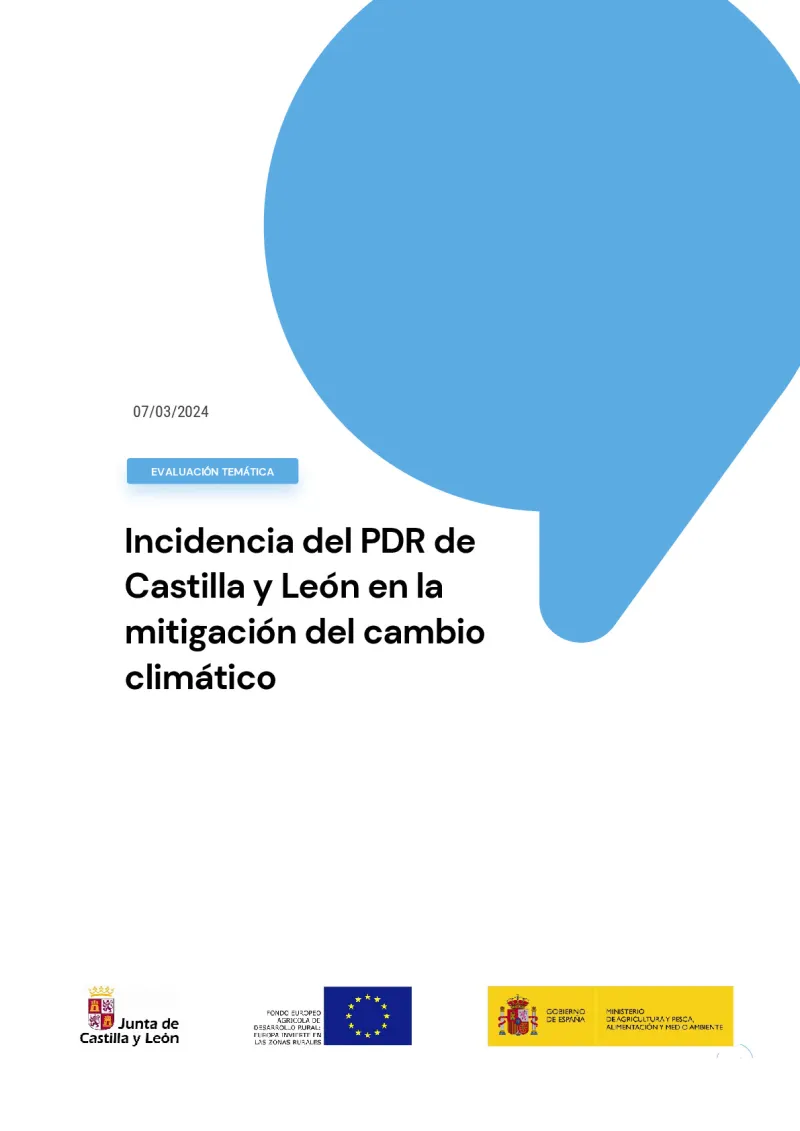Impact of the Castilla y León RDP on climate change
The report examines the impact of the Rural Development Programme (RDP) of Castilla y León on climate change mitigation, including an in-depth analysis of climate change, energy efficiency,and renewable energies, as well as the impact of agri-environmental measures on greenhouse gas (GHG) emissions.
- Spain
- 2014-2022
- Environmental impacts

This document addresses the Impact of the RDP of Castilla y León and the mitigation of climate change. It includes three parts : (1) the in-depth analyses carried out in 2018 on the topic of climate change, (2) the analysis performed in 2022 on energy efficiency and renewable energies, and (3) the work done in 2022 on the impact of agri-environment-climate measures on greenhouse gas emissions.
The report focuses on the actions taken under the RDP to mitigate climate change. It aims to assess the extent to which the actions of the RDP have an impact on achieving a more efficient use of energy in agriculture and food processing, manage to boost the use of renewable energy sources, reduce greenhouse gas and ammonia emissions from agriculture and preserve and capture carbon.
The first part of the report presents a deeper understanding of the type of actions promoted by the RDP in the area of climate change and the effects foreseen, consolidating the intervention logic that allows answering the evaluation questions. It explores the sources of available information, identifies key stakeholders and defines the information needed. It also advances in the methodological definition and calculation of indicators.
The second part analyses in more depth the RDP's impact on improving energy efficiency and promoting renewable energies.
The RDP is one of the main sources of funding for carrying out the energy efficiency in irrigation programme, through Measures 4.3 to support the modernisation of irrigation infrastructure, 4.1 to support the modernisation of irrigation on farms, and 16.2 to promote cooperation in research, development, and innovation (R&D&I). Thanks to Measure 4.3, the eight works envisaged for alternative energies are already in the tendering phase, which will cover almost 22 000 hectares and produce 21.3 million kWh/year. Through the line dedicated to new pressure irrigation technologies, whose tests are being carried out with funding from Measure 16.2 of the RDP, a reduction of up to 30% in the contracted power can be achieved. Additionally, Measure 4.3 encourages natural pressure irrigation, utilising height differences to minimise energy consumption.
There are other cross-cutting RDP measures contributing to energy efficiency and the development of alternative energies. In the first place, training Measure 1.1, with 59 actions contributing to Focus Areas 5B and 29 to 5C, saw 2 651 and 1 459 attendees participate, respectively, and covering all provinces. Measure 1.2, supporting demonstration actions, has also contributed to energy use improvement objectives, with 22 dossiers contributing to Focus Areas 5B or 5C.
Regarding advisory services, user surveys have revealed that 56% have received advice on more efficient energy use, and 49% on the use of renewable energy and the circular economy.
Another relevant cross-cutting measure is 16.2, which focuses on cooperation in R&D&I. Under this aid, several projects have been developed to promote energy savings in agro-industries and agriculture, focusing on the cultivation of more resilient and environmentally friendly crops, as well as the development of the bioeconomy.
Finally, the LEADER Measure 19.2 has supported up to 56 actions contributing to the development of renewable energy and the bioeconomy. Most of these actions involved investments aimed at promoting the supply and use of renewable sources of energy, by-products, waste, residues and other non-food raw materials to foster the development of the bioeconomy, in both the productive field and the infrastructure and basic services sector, as well as the valorisation of rural heritage.
Author(s)
Red2Red